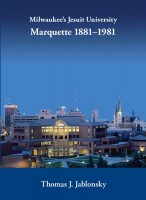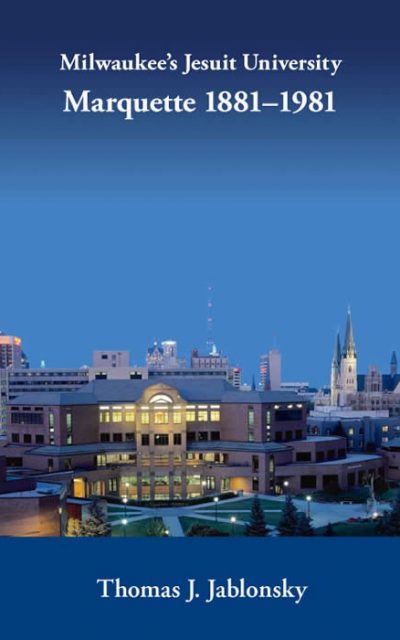 Author: Thomas J. Jablonsky
Author: Thomas J. Jablonsky
Publisher: Marquette University Press – 438 pages
Book Review by: Paiso Jamakar
This is the story of Marquette, the largest private university in Wisconsin and the first Catholic college or university in the world to become a co-educational institution by admitting women.
The author Thomas Jablonsky has been with the Milwaukee-based Marquette University since 1995, and is currently director of its Institute for Urban Life, so he is uniquely qualified as the author of this book.
He has expertly researched and laid out the materials in this book with great care, and he has written the history of the birth and growth of Marquette University with a lot of interesting facts. (The Notes section alone is over 40 pages in length).
This large volume contains many images that help the reader better understand the story.
There are pictures, sketches and other types of illustrations as aids that relate the highlights of the history of this unique Jesuit university.
Photographs of buildings, the campus, news clippings, pamphlets, parks, people, statues and other depictions are provided that show university and city life, many of them half page in size, and some even full page. Pictures often tell parts of stories better than words, even when they are black and white such as in this book.
So, in his book you will find photos of gatherings of people at numerous places like chapels, classrooms, dining halls, dormitories, lodges, physics and speech labs, stadiums and student residence buildings; events like university games, graduations, parades, protests, theater plays and student government meetings; people and groups of people like basketball teams and football coaches and players; and objects like old phones and trophies.
Jablonsky writes that Milwaukee’s first bishop – John Martin Henni – opened Marquette College to teach liberal arts in September 1981, naming it after the French explorer Pere Jacques Marquette. It was built on a hilltop that overlooked its downtown, and it was founded on the traditions of the Society of Jesus.
For about a quarter century there was not much growth but in 1907 it merged with Milwaukee Medical College; in 1908 it purchased two private law schools and an engineering college; and in 1910 it started courses in business and journalism. By then, Marquette College had moved from its original hilltop location to Grand Avenue, near the Church of the Gesu.
Much growth followed in the 1920s with the school’s first building boom. But the Great Depression of the 1930s brought about financial hardships to the institution and World War II in the 1940s caused enrollment disruptions. After that major conflict Marquette came into full glory.
By the late 1950s it had become the largest Catholic university in the United States. Then there was an urban renewal program for about a quarter century preceding its first centenary that dramatically improved the neighborhood surrounding its campus.
That period prior to 1981 brought about a lay-dominated core of leaders. The 1960s and 1970s saw an outspoken student body that freely expressed their feelings.
The nine chapters of this book are based on a chronology of events in the history of Marquette University. Each chapter covers a period relating to a theme in the institution’s history. Here is an overview from which you can decide which chapter to read first:
- The Jesuits Come to Milwaukee: 1844-1880
- A Jesuit Liberal Arts College: 1881-1906
- Great Transformations: 1906-1916
- Milwaukee’s University: 1917-1928
- Troubled Times: 1928-1945
- Postwar Adjustments: 1945-1954
- Transition to Prominence: 1954-1962
- New Dimensions and Powerful Disruptions: 1962-1971
- Search for a New Order: 1960s-1981
The author has based this book on university archives, the many aspects of student life, decisions by its administrations over the years, and the role of Marquette in the city of Milwaukee.







